Tragic Second World War Accidents in Northern Ireland By Nigel Henderson
Whilst the vast proportion of the civilian deaths attributable to the Second World War in Northern Ireland occurred during the German Air Raids on Belfast, Newtownards and Londonderry in April/May 1941, there are other deaths recorded on the Civilian War Dead section of the Commonwealth War Graves Commission (CWGC) database, which lists 906 civilian fatalities.
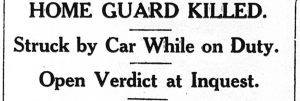 The first fatality on the CWGC list is Special Constable William Mould (Local Defence Volunteer, forerunner of the Ulster Home Guard) of Dunmurry who died at 4:30am on 8th September 1940 when he was struck by a vehicle with no lights when walking home whilst on duty. The car was driven by Lieutenant Ernest John Bloom, Corps of Royal Signals and reports on the inquest were carried by the Lisburn Standard and Lisburn Herald (on 13th and 14th September respectively). William Moulds had served with the Canadian Infantry during the Great War and is commemorated on the War Memorial in Derriaghy Church of Ireland. To date I have been unable to locate the burial location.
The first fatality on the CWGC list is Special Constable William Mould (Local Defence Volunteer, forerunner of the Ulster Home Guard) of Dunmurry who died at 4:30am on 8th September 1940 when he was struck by a vehicle with no lights when walking home whilst on duty. The car was driven by Lieutenant Ernest John Bloom, Corps of Royal Signals and reports on the inquest were carried by the Lisburn Standard and Lisburn Herald (on 13th and 14th September respectively). William Moulds had served with the Canadian Infantry during the Great War and is commemorated on the War Memorial in Derriaghy Church of Ireland. To date I have been unable to locate the burial location.
Several people, mainly teenaged boys, died when they picked up explosive devices but there were also tragedies involving the sea and gas leaks … and a few deaths involving British and American military personnel.
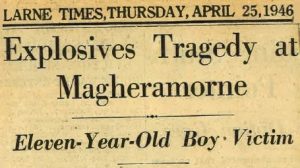
Thomas Barr Murray of Magheramorne in County Antrim was out playing with some friends in a disused quarry on his eleventh birthday on 17th April 1946. The quarry had been used by a rifle range during the war and Tommy picked up an object, which turned out to be a No 68 Anti-Tank Grenade, and he was hitting in with a stone when it exploded, killing him instantly and badly wounding his best friend, John McBroom. The Larne Times (25th March 1946) reported on the inquest and Tommy was laid to rest in St John’s Church of Ireland Graveyard in Glynn.
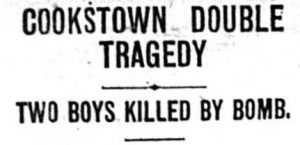
Tragedy struck Cookstown on Sunday 14th February 1943. Whilst playing in Killymoon Demesne, some local lads discovered an anti-tank grenade which they took to two soldiers, who declared that it was safe. Daniel Donnelly (13) grabbed the grenade from John Woods and ran off with his friend, John Creggan (11), and the grenade exploded a short while later. The two boys were transported to the County Hospital in Omagh, but Daniel died en-route at Mountfield and John died of his injuries in hospital. On Tuesday 16th February, a Solemn Requiem was said by the local parish priest Father Teggart CC and the boys were buried in the Derryloran Chapel Hill Roman Catholic Graveyard in Cookstown. Whilst Daniel’s name is recorded on the CWGC Civilian War Dead list, John’s name is not … one of several anomalies that I have detected. The inquest was reported in the Mid Ulster Mail on 20th February 1943.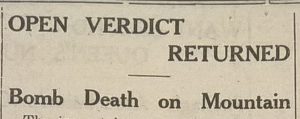
The inquest into the circumstances of the death on 14th November 1945 of Thomas Molloy (16) of Terla, Tassagh, at the military range on Corran Mountain took place on 23rd November and was reported in the Armagh Guardian on 30th November 1945. According to Mrs Jane Cassells of Corran, the lad was driving a herd of cattle towards the Clady. Mr Murphy, the owner of the field, expressed the view that the cattle might have detonated an explosive device. The story of a distressing tragedy was unfurled at an Inquest in Limavady under Dr John Acheson, Deputy Coroner. Albert Rodden (28), a driver with the Northern Ireland Road Transport Board was killed by a short burst of machine gun fire on the evening of 17th April 1942 on the Dungiven-Limavady Road.
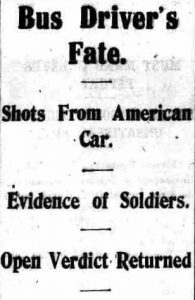 Rodden, accompanied by Frederick McMichael, was returning the bus to the depot in Ballyclare. In giving evidence, Frederick McMichael said that Albert had allowed several vehicles to pass the bus in Main Street, Dungiven before pulling out behind them – there was a further, but different car, behind the bus and the driver of the car sounded the horn and tried to overtake. At Farloe Lane, there was a wide place and Albert pulled in to let the car pass and, as the other car came along at a fast rate, McMichael heard a shot and the bus crashed into a wall. Driver De Felice said that when he tried to pass the bus, the car struck the kerb and his passenger, Sergeant Clipsham swayed with the sudden jerk and appeared to be dumbfounded as if he did not know what had happened. In giving evidence, Sergeant Clipsham reported that he was standing in the car and fell against the machine gun, which started to fire. The funeral at Ballykelly Presbyterian Church was a major affair, including representatives from the “B” Constabulary and the Ulster Home Guard, which would imply that he was providing part-time war service, yet his name is not recorded in the Books of Remembrance for civilian fatalities in the Second World War. The inquest was reported in the Derry Standard and the Derry Journal on 20th April 1942 and in the Londonderry Sentinel on 21st April 1942.
Rodden, accompanied by Frederick McMichael, was returning the bus to the depot in Ballyclare. In giving evidence, Frederick McMichael said that Albert had allowed several vehicles to pass the bus in Main Street, Dungiven before pulling out behind them – there was a further, but different car, behind the bus and the driver of the car sounded the horn and tried to overtake. At Farloe Lane, there was a wide place and Albert pulled in to let the car pass and, as the other car came along at a fast rate, McMichael heard a shot and the bus crashed into a wall. Driver De Felice said that when he tried to pass the bus, the car struck the kerb and his passenger, Sergeant Clipsham swayed with the sudden jerk and appeared to be dumbfounded as if he did not know what had happened. In giving evidence, Sergeant Clipsham reported that he was standing in the car and fell against the machine gun, which started to fire. The funeral at Ballykelly Presbyterian Church was a major affair, including representatives from the “B” Constabulary and the Ulster Home Guard, which would imply that he was providing part-time war service, yet his name is not recorded in the Books of Remembrance for civilian fatalities in the Second World War. The inquest was reported in the Derry Standard and the Derry Journal on 20th April 1942 and in the Londonderry Sentinel on 21st April 1942.
 Joseph Herbert Withers (11) died at the Armagh County Infirmary on 22nd October 1941 following an explosion on Aughnagurgan Mountain – an elderly man, Nathaniel Weir was injured and taken to hospital. William Russell, farmer of Aughnagurgan, said he saw Weir working in a corn field and there was a child carrying corn when he saw a plume of smoke and heard an explosion. Joseph Withers, who was still conscious, said that he got the bomb on the mountain and it exploded when he threw it down. Archibald Withers, the lad’s father was working in a nearby field and heard the explosion. The inquest was reported in the Ulster Gazette & Armagh Standard on 31st October 1941.
Joseph Herbert Withers (11) died at the Armagh County Infirmary on 22nd October 1941 following an explosion on Aughnagurgan Mountain – an elderly man, Nathaniel Weir was injured and taken to hospital. William Russell, farmer of Aughnagurgan, said he saw Weir working in a corn field and there was a child carrying corn when he saw a plume of smoke and heard an explosion. Joseph Withers, who was still conscious, said that he got the bomb on the mountain and it exploded when he threw it down. Archibald Withers, the lad’s father was working in a nearby field and heard the explosion. The inquest was reported in the Ulster Gazette & Armagh Standard on 31st October 1941.
Robert John Dodds, a 40-year-old farmer from Dysert and a member of the “B” Specials Constabulary since 1921, found a bomb or grenade whilst ploughing a field on Tuesday 26th January 1943 and showed it to his brother, Aaron Dodds. At 8:20 on Wednesday evening, Robert John Dodd left the family home to walk to the “B” Specials Drill Hall – he had the bomb in his coat pocket as he would have to take it to Mr Noble, the Instructor. 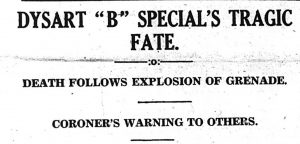 When he was 50 yards from the house, the bomb exploded and Robert John Dodd was taked to Daisy Hill Hospital in Newry, where he later died. The inquest was reported in the Newry Reporter on 30th January 1943.
When he was 50 yards from the house, the bomb exploded and Robert John Dodd was taked to Daisy Hill Hospital in Newry, where he later died. The inquest was reported in the Newry Reporter on 30th January 1943.
Frederick Strutt (31), a civilian worker from Dublin was working on the runway lighting at Ballyhalbert Airfield on 4th November 1942 and died when a Beaufort aircraft piloted by Sergeant G.B. Swift of 153 Squadron Royal Air Force ran off the runway and struck him – Frederick Strutt is buried in Deansgrange Cemetery at Drumcondra in Dublin. Seven days later, Sergeant Swift (Aus 406552) and his Crewman Sgt D.J. Blanchard were transferred to 29 Squadron. (Additional information from Andy Greenfield, www.ww2ni.com). The inquest was reported in the Newtownards Chronicle on 14th November 1942.

At the outbreak of war, the pilot launch Miss Betty was requisitioned by the Admiralty from Jim Davidson of Donaghadee and was crewed by civilians under naval direction. On Saturday 8 May 1943, Miss Betty left Bangor in moderate weather conditions at 8.55 am to respond to a call from a ship entering Belfast Lough. At 11.40 am, Miss Betty was returning to Bangor harbour, contending with a strong north-easterly gale and heavy breaking seas, when disaster struck 60 to 70 yards from the safety. The boat had successfully negotiated several strong waves before being overwhelmed by a broadside hit on the port side. Miss Betty capsized, turned over in the water and remained upside down. 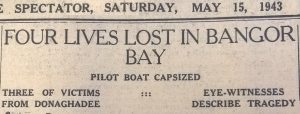 Four North Down men drowned in the incident. Harry Aiken (21), William George Nelson (28, and a crew member of the Donaghadee Lifeboat) and William White (29) from Donaghadee are commemorated on the Donaghadee War Memorial and buried in the Donaghadee Church of Ireland graveyard. The body of William Sloan Anderson (28) from Bangor was washed ashore at Portpatrick in Scotland 38 days after the disaster and he is buried in the Bangor Cemetery and is commemorated on the Bangor War Memorial and on the War Memorial in the Wesley Centenary Methodist Church in Bangor. Although these men lost their lives whilst working under the direction of the Admiralty, they are not recorded as civilian war fatalities on the CWGC database. (additional material provided by Barry Niblock)
Four North Down men drowned in the incident. Harry Aiken (21), William George Nelson (28, and a crew member of the Donaghadee Lifeboat) and William White (29) from Donaghadee are commemorated on the Donaghadee War Memorial and buried in the Donaghadee Church of Ireland graveyard. The body of William Sloan Anderson (28) from Bangor was washed ashore at Portpatrick in Scotland 38 days after the disaster and he is buried in the Bangor Cemetery and is commemorated on the Bangor War Memorial and on the War Memorial in the Wesley Centenary Methodist Church in Bangor. Although these men lost their lives whilst working under the direction of the Admiralty, they are not recorded as civilian war fatalities on the CWGC database. (additional material provided by Barry Niblock)
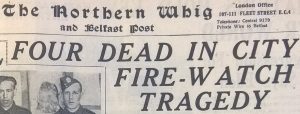 Messrs Redmond, Sons & Company, a manufacturer of packing cases, employed a night-watchman and fire-watchers at its premises on the corner of Connaught Street and Milner Street in the Village district of South Belfast. When William Elliott arrived at the works at 7:30am on the morning of 2nd December 1942, he found the night-watchman, Alexander Watson of Coolderry Street, lying on the floor in front of a gas fire and later found the four fire-watchers in their beds – two men, William Dowling of Donegall Avenue and James Campbell of Norfolk Drive, were already dead and the other two men were taken to the near-by Royal Victoria Hospital. George Leslie of Olympic Drive died in hospital but Henry Kavanagh (18) of Ross Street survived. The gas fire and the radiator in the sleeping quarters had been installed only ten days previously and, whilst William Elliott reported that he had noticed a strong smell of gas, a Corporation expert examined the radiator and reported that it was in perfect order and that there was no sign of an escape of gas. James Campbell (18) was buried in Milltown Roman Catholic Cemetery, William John Dowling (49) was buried in Dundonald Cemetery, George Leslie (37) was buried in Belfast City Cemetery and Alexander Watson (63) was buried in Lurgan Cemetery.
Messrs Redmond, Sons & Company, a manufacturer of packing cases, employed a night-watchman and fire-watchers at its premises on the corner of Connaught Street and Milner Street in the Village district of South Belfast. When William Elliott arrived at the works at 7:30am on the morning of 2nd December 1942, he found the night-watchman, Alexander Watson of Coolderry Street, lying on the floor in front of a gas fire and later found the four fire-watchers in their beds – two men, William Dowling of Donegall Avenue and James Campbell of Norfolk Drive, were already dead and the other two men were taken to the near-by Royal Victoria Hospital. George Leslie of Olympic Drive died in hospital but Henry Kavanagh (18) of Ross Street survived. The gas fire and the radiator in the sleeping quarters had been installed only ten days previously and, whilst William Elliott reported that he had noticed a strong smell of gas, a Corporation expert examined the radiator and reported that it was in perfect order and that there was no sign of an escape of gas. James Campbell (18) was buried in Milltown Roman Catholic Cemetery, William John Dowling (49) was buried in Dundonald Cemetery, George Leslie (37) was buried in Belfast City Cemetery and Alexander Watson (63) was buried in Lurgan Cemetery.

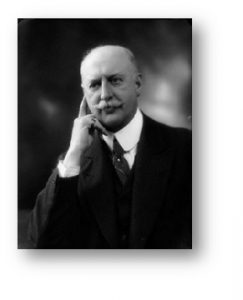
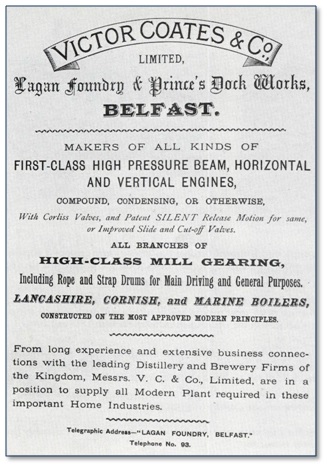
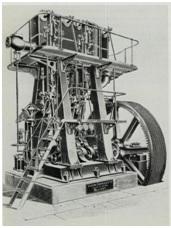


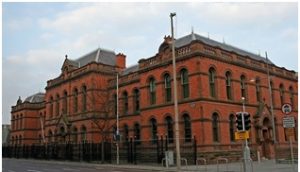
 William and Elsie’s first son Frederick Gregory Lindsay Coates was born on 19 May, 1916 at Glynn Park. A second child, a daughter named Jean Ann Dorothy Coates, was born 3 years later – she later emigrated to Virginia following her marriage to Roland Sinclair, son of Sir Kenneth Sinclair of Windsor Park, and her descendants still live in the United States today.
William and Elsie’s first son Frederick Gregory Lindsay Coates was born on 19 May, 1916 at Glynn Park. A second child, a daughter named Jean Ann Dorothy Coates, was born 3 years later – she later emigrated to Virginia following her marriage to Roland Sinclair, son of Sir Kenneth Sinclair of Windsor Park, and her descendants still live in the United States today.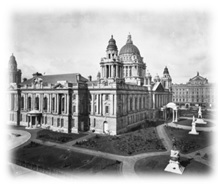
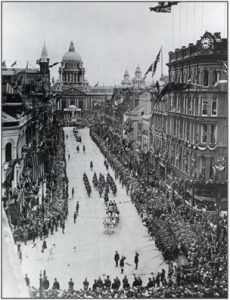
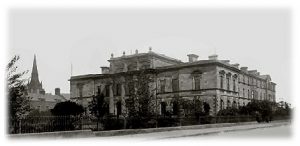
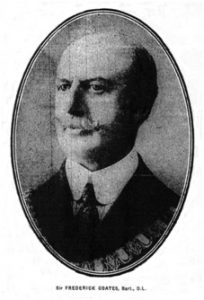

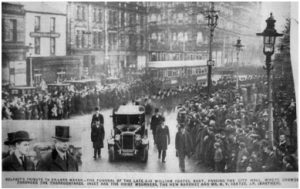
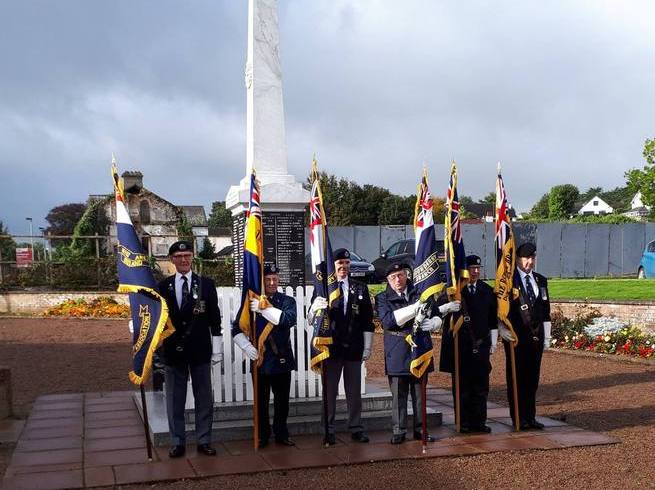
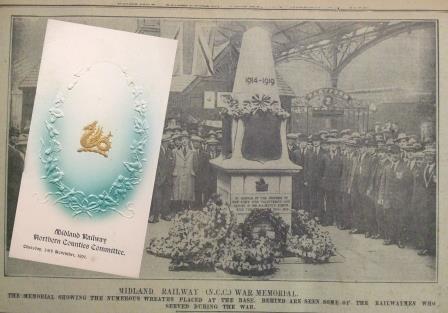

 James McGuigan had initially joined a reserve battalion of the Connaught Rangers but was deployed to the 8th Battalion Royal Inniskilling Fusiliers in France. As with Benjamin Anderson, James McGuigan died during the 1916 Battles of the Somme, being killed in action with the 16th Irish Division on 9th September 1916 during the Battle of Ginchy. James Joseph McGuigan was born at Albert Street in Belfast on 4th June 1879 to Patrick McGuigan and Catherine Ahern and he married Mary Drain at the Roman Catholic Chapel in Randalstown on 29 December 1906. James and Sarah were living at Drumsough in Sharvogues in 1911 and they had seven children, the first child (Peter) being born in May 1907 and the last child (Lizzie) being born in March 1915.
James McGuigan had initially joined a reserve battalion of the Connaught Rangers but was deployed to the 8th Battalion Royal Inniskilling Fusiliers in France. As with Benjamin Anderson, James McGuigan died during the 1916 Battles of the Somme, being killed in action with the 16th Irish Division on 9th September 1916 during the Battle of Ginchy. James Joseph McGuigan was born at Albert Street in Belfast on 4th June 1879 to Patrick McGuigan and Catherine Ahern and he married Mary Drain at the Roman Catholic Chapel in Randalstown on 29 December 1906. James and Sarah were living at Drumsough in Sharvogues in 1911 and they had seven children, the first child (Peter) being born in May 1907 and the last child (Lizzie) being born in March 1915.



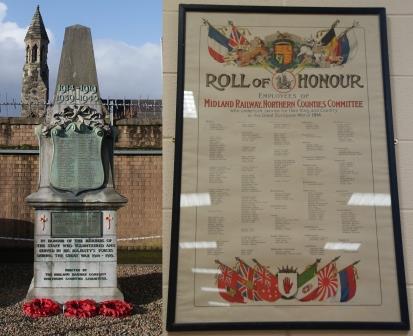

 The Cleaver family originated in Scotland where one of the earliest recorded marriages took place between William Cleaver and Elizabeth Dunstone on 2nd February 1770. William served in the army, and the couple’s children were born and raised in the parish of Kilmallie, near Fort William in the Scottish Highlands. Upon his death in 1787, the family moved to Bishopstone, a small village close to the south coast of England in East Sussex.
The Cleaver family originated in Scotland where one of the earliest recorded marriages took place between William Cleaver and Elizabeth Dunstone on 2nd February 1770. William served in the army, and the couple’s children were born and raised in the parish of Kilmallie, near Fort William in the Scottish Highlands. Upon his death in 1787, the family moved to Bishopstone, a small village close to the south coast of England in East Sussex.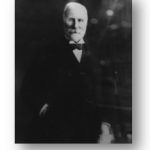 John Cleaver was born in Bishopstone on 23rd September 1841, the great grandson of William Cleaver of Fort William. He served his apprenticeship in retail in London, and in a bid to further his career, he crossed the Irish Sea in 1865 to manage one of the departments in the established firm of James Lindsay & Co; general drapers, silk mercers and linen merchants at the Ulster Arcade on Donegall Place. The Lindsay family had themselves made their way to Ireland from Scotland in 1678, where they played an active role in the Relief of Derry in 1689, before moving to Belfast to establish a “woollen, linen and haberdashery warehouse” at 15 Bridge Street, the then centre of commerce in the town, in 1822.
John Cleaver was born in Bishopstone on 23rd September 1841, the great grandson of William Cleaver of Fort William. He served his apprenticeship in retail in London, and in a bid to further his career, he crossed the Irish Sea in 1865 to manage one of the departments in the established firm of James Lindsay & Co; general drapers, silk mercers and linen merchants at the Ulster Arcade on Donegall Place. The Lindsay family had themselves made their way to Ireland from Scotland in 1678, where they played an active role in the Relief of Derry in 1689, before moving to Belfast to establish a “woollen, linen and haberdashery warehouse” at 15 Bridge Street, the then centre of commerce in the town, in 1822.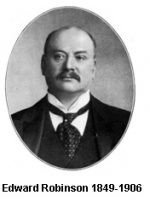 It was during his time at Lindsay Brothers, that John Cleaver met Edward Robinson, a young man from Ballymena, who had earlier secured for himself an apprenticeship with the same company. His father Alexander, was a woollen draper in the County Antrim town. Both men soon realised the enormous potential for the development of the sale of Irish linen products, and with financial assistance from their families, set up a business partnership in premises on Castle Place in 1870, styled as Robinson & Cleaver.
It was during his time at Lindsay Brothers, that John Cleaver met Edward Robinson, a young man from Ballymena, who had earlier secured for himself an apprenticeship with the same company. His father Alexander, was a woollen draper in the County Antrim town. Both men soon realised the enormous potential for the development of the sale of Irish linen products, and with financial assistance from their families, set up a business partnership in premises on Castle Place in 1870, styled as Robinson & Cleaver. 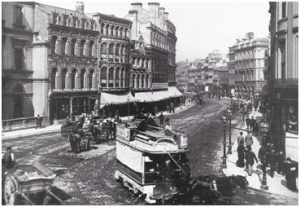 The success of their business was based on the fact that until that time, it had been almost impossible to obtain locally produced goods at reasonable prices. They were quick to identify this gap in the market and within a short space of time, the business had expanded and the partnership moved to larger premises on High Street (left) in 1879. The potential for growth of such a business in Belfast at that time was phenomenal.
The success of their business was based on the fact that until that time, it had been almost impossible to obtain locally produced goods at reasonable prices. They were quick to identify this gap in the market and within a short space of time, the business had expanded and the partnership moved to larger premises on High Street (left) in 1879. The potential for growth of such a business in Belfast at that time was phenomenal.
 In addition to raising a large family, the business at High Street continued to expand. Belfast was fast becoming one of the leading manufacturing cities of the British Empire, with markets for products produced in North East Ireland opening up across the civilised world. The partners were not slow to capitalise on this phenomenal growth and soon they were supplying high quality items of Irish linen to households across the United Kingdom. Soon the company outgrew their premises on High Street and by the mid-1880s the partners began to look for larger premises. They purchased one of the last residential houses on Donegall Place (see right) which had a large garden onto Donegall Square North, and quickly commissioned one of the leading architects of the day, Young & McKenzie, to design a building that would be fitting for the business they had grown over the past 15 years. The vast majority of parcels despatched from Belfast came from the house of Robinson & Cleaver and the company pioneered overseas sales via their brochures to homes and businesses across the empire.
In addition to raising a large family, the business at High Street continued to expand. Belfast was fast becoming one of the leading manufacturing cities of the British Empire, with markets for products produced in North East Ireland opening up across the civilised world. The partners were not slow to capitalise on this phenomenal growth and soon they were supplying high quality items of Irish linen to households across the United Kingdom. Soon the company outgrew their premises on High Street and by the mid-1880s the partners began to look for larger premises. They purchased one of the last residential houses on Donegall Place (see right) which had a large garden onto Donegall Square North, and quickly commissioned one of the leading architects of the day, Young & McKenzie, to design a building that would be fitting for the business they had grown over the past 15 years. The vast majority of parcels despatched from Belfast came from the house of Robinson & Cleaver and the company pioneered overseas sales via their brochures to homes and businesses across the empire.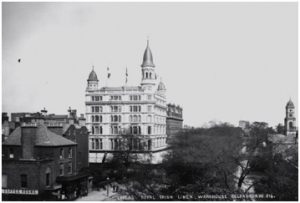 The ‘Royal Irish Linen Warehouse’ of Robinson & Cleaver opened for business on September 1888, the same year that Belfast received its charter as a city. With success came great wealth for the founding partners and by this time, they would have been the equivalent of millionaires in today’s money. This precipitated a move to a larger house on the Malone Road for the Cleaver family – a large Victorian terrace opposite Fisherwick Presbyterian Church.
The ‘Royal Irish Linen Warehouse’ of Robinson & Cleaver opened for business on September 1888, the same year that Belfast received its charter as a city. With success came great wealth for the founding partners and by this time, they would have been the equivalent of millionaires in today’s money. This precipitated a move to a larger house on the Malone Road for the Cleaver family – a large Victorian terrace opposite Fisherwick Presbyterian Church. In 1892, such was the success of Robinson & Cleaver, that John Cleaver moved residence again, this time to the estate of ‘Dunraven’ on the Malone Road. Dunraven, a large Italianate Villa, had been built for the timber magnate and shipowner, James Porter Corry in 1870. It extended over several acres with its own lake and extensive parkland. It was in this house that John and Mary would spend the rest of their lives.
In 1892, such was the success of Robinson & Cleaver, that John Cleaver moved residence again, this time to the estate of ‘Dunraven’ on the Malone Road. Dunraven, a large Italianate Villa, had been built for the timber magnate and shipowner, James Porter Corry in 1870. It extended over several acres with its own lake and extensive parkland. It was in this house that John and Mary would spend the rest of their lives.  By 1900, his eldest son, (aged 29) Arthur Spencer Cleaver, in addition to becoming a director of Robinson & Cleaver, had embarked on a military career and became a second Lieutenant in the Southern Division of the Mid Ulster (Royal Field) Artillery (left) – a regiment within the British Army. He removed to London, primarily to look after the Regent Street store at the same time becoming an Honorary Lieutenant Colonel with the Royal Garrison Artillery, 1st Reserve Battery.
By 1900, his eldest son, (aged 29) Arthur Spencer Cleaver, in addition to becoming a director of Robinson & Cleaver, had embarked on a military career and became a second Lieutenant in the Southern Division of the Mid Ulster (Royal Field) Artillery (left) – a regiment within the British Army. He removed to London, primarily to look after the Regent Street store at the same time becoming an Honorary Lieutenant Colonel with the Royal Garrison Artillery, 1st Reserve Battery.  It was however his wife, Adelaide, who achieved notoriety as an adventurer and women pioneer in aviation in the 1920s and 30s. She was an avid mountain climber, expert driver and skilled motor mechanic. Adelaide Franklin Pollock was born in Newtownards in 1896, the eldest daughter of the Rt Hon Hugh MacDowell Pollock, first Minister of Finance in the Government of Northern Ireland created in 1921. Having developed an important flour importing business, Pollock was independently wealthy, and as Chairman of the Belfast Harbour Commissioners had one of the docks named in his honour. Coming from such a privileged position within Ulster Society this was the type of union John Cleaver would have nurtured and encouraged for his offspring.
It was however his wife, Adelaide, who achieved notoriety as an adventurer and women pioneer in aviation in the 1920s and 30s. She was an avid mountain climber, expert driver and skilled motor mechanic. Adelaide Franklin Pollock was born in Newtownards in 1896, the eldest daughter of the Rt Hon Hugh MacDowell Pollock, first Minister of Finance in the Government of Northern Ireland created in 1921. Having developed an important flour importing business, Pollock was independently wealthy, and as Chairman of the Belfast Harbour Commissioners had one of the docks named in his honour. Coming from such a privileged position within Ulster Society this was the type of union John Cleaver would have nurtured and encouraged for his offspring.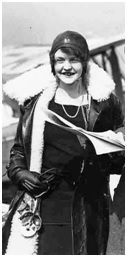 See thread on Rootschat here:
See thread on Rootschat here:  Gordon Neil Spencer ‘Mouse’ Cleaver was born in Stanmore, Middlesex, in 1910, and educated at Harrow. As an accomplished skier, he was the inaugural winner of the ‘Hahnenkammrennen Combined’ in Austria in 1931. The ‘Cleaver Cup’ was subsequently named after his success on the slopes. He joined 601 Fighter Squadron (The Millionaire’s Squadron) Auxiliary Air Force in 1937, being promoted to the position of Flying Officer in October 1938. Upon the outbreak of the Second World War he was mobilised in November 1939, travelling to France with his Squadron to Merville in Northern France. He claimed 7 confirmed “kills” during the Battle of Britain before his hurricane was shot down during combat over Winchester. Although he baled out, the fragments from the Perspex canopy on his plane, shattered into his eyes and face blinding him in the right eye. For his valour, he was awarded the Distinguished Flying Cross (DFC). Despite his injuries he remained in the RAF throughout the war, being released on medical grounds in November 1943, retaining the rank of Squadron Leader. Following on from the injuries he received, Cleaver underwent 18 operations on his eyes under the accomplished eye surgeon Harold Ridley. It was during work carried out during these procedures that Ridley developed the intraocular lens, a major development in repairing damage to the human eye.
Gordon Neil Spencer ‘Mouse’ Cleaver was born in Stanmore, Middlesex, in 1910, and educated at Harrow. As an accomplished skier, he was the inaugural winner of the ‘Hahnenkammrennen Combined’ in Austria in 1931. The ‘Cleaver Cup’ was subsequently named after his success on the slopes. He joined 601 Fighter Squadron (The Millionaire’s Squadron) Auxiliary Air Force in 1937, being promoted to the position of Flying Officer in October 1938. Upon the outbreak of the Second World War he was mobilised in November 1939, travelling to France with his Squadron to Merville in Northern France. He claimed 7 confirmed “kills” during the Battle of Britain before his hurricane was shot down during combat over Winchester. Although he baled out, the fragments from the Perspex canopy on his plane, shattered into his eyes and face blinding him in the right eye. For his valour, he was awarded the Distinguished Flying Cross (DFC). Despite his injuries he remained in the RAF throughout the war, being released on medical grounds in November 1943, retaining the rank of Squadron Leader. Following on from the injuries he received, Cleaver underwent 18 operations on his eyes under the accomplished eye surgeon Harold Ridley. It was during work carried out during these procedures that Ridley developed the intraocular lens, a major development in repairing damage to the human eye. His second son, (John) Martin Cleaver, born in 1871, was educated in England and Germany, gaining a BA from the Royal University of Ireland (precursor to QUB) and graduating from TCD with a law degree in 1893. He set up his own practice as a solicitor later that year at premises on Wellington Place. In 1897, he took into partnership William Fulton, whose father John Fulton, was a linen manufacturer at the firm of John Fulton & Co on Ormeau Avenue. The partnership was style as Cleaver & Fulton. Both the Cleavers and Fultons were Methodists, with John Fulton being greatly interested in Foreign Missions, in addition to being solicitor to the Board of Governors at Methodist College. Soon after the partnership was established, Martin Cleaver, influenced by Fulton’s vision, retired from the law, devoting his whole time to the Egypt General Mission of which he was one of the founders. He arrived in Alexandria, Egypt on 31st January 1898, one of a group of 7 missionaries where he met Aileen Mary White, who had also carried out missionary work in Egypt. After their marriage, they both returned to Alexandria, but after four years of travelling in North Africa, his health broke down, and he took up residence in London as Secretary to the Mission.He later went on to co-found the ‘Fellowship of Faith for the Muslims’ (1915) an international fellowship of Christians who have a concern for the Muslim world, publishing such pamphlets as “Why do the Muslims need the Gospel?”Having been at Keswick in 1915, he returned to visit his father at Dunraven in Belfast, but became ill and died during that visit in August of that year. Both J Martin Cleaver and his wife Aileen are buried at Belfast City Cemetery. The company he established in 1893, Cleaver Fulton Rankin, remains one of Northern Ireland’s leading law firms.
His second son, (John) Martin Cleaver, born in 1871, was educated in England and Germany, gaining a BA from the Royal University of Ireland (precursor to QUB) and graduating from TCD with a law degree in 1893. He set up his own practice as a solicitor later that year at premises on Wellington Place. In 1897, he took into partnership William Fulton, whose father John Fulton, was a linen manufacturer at the firm of John Fulton & Co on Ormeau Avenue. The partnership was style as Cleaver & Fulton. Both the Cleavers and Fultons were Methodists, with John Fulton being greatly interested in Foreign Missions, in addition to being solicitor to the Board of Governors at Methodist College. Soon after the partnership was established, Martin Cleaver, influenced by Fulton’s vision, retired from the law, devoting his whole time to the Egypt General Mission of which he was one of the founders. He arrived in Alexandria, Egypt on 31st January 1898, one of a group of 7 missionaries where he met Aileen Mary White, who had also carried out missionary work in Egypt. After their marriage, they both returned to Alexandria, but after four years of travelling in North Africa, his health broke down, and he took up residence in London as Secretary to the Mission.He later went on to co-found the ‘Fellowship of Faith for the Muslims’ (1915) an international fellowship of Christians who have a concern for the Muslim world, publishing such pamphlets as “Why do the Muslims need the Gospel?”Having been at Keswick in 1915, he returned to visit his father at Dunraven in Belfast, but became ill and died during that visit in August of that year. Both J Martin Cleaver and his wife Aileen are buried at Belfast City Cemetery. The company he established in 1893, Cleaver Fulton Rankin, remains one of Northern Ireland’s leading law firms.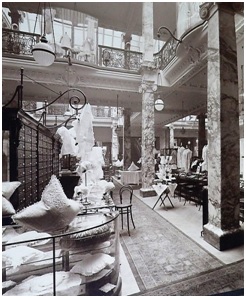 John Cleaver’s third son, (James) Frederick was born at Ashley Villa on 8th June 1875, and after being educated in Belfast and Germany, he travelled the world, visiting Australia and New Zealand, before following his father into the family business at Robinson & Cleaver, in 1895. The firm had developed branches throughout the UK including Regent Street, London; and Church Street, Liverpool. The importance of the company to the economy of Belfast cannot be underestimated. Robinson & Cleaver sent more parcels containing linen products of Irish manufacture out of the city of Belfast than any other business. Their store on London’s Regent Street was one of the most opulent and exclusive in the capital (right). He soon became Managing Director of the firm at its headquarters on Donegall Place (1906) and resided at a house called ‘Bishopstone’ on Deramore Park, recalling the origins of his father’s home in Essex. He married, in 1901, Sarah Hammond Fulton, eldest daughter of John Fulton and sister of the partner of his brother’s law firm, Cleaver and Fulton (see J Martin Cleaver).
John Cleaver’s third son, (James) Frederick was born at Ashley Villa on 8th June 1875, and after being educated in Belfast and Germany, he travelled the world, visiting Australia and New Zealand, before following his father into the family business at Robinson & Cleaver, in 1895. The firm had developed branches throughout the UK including Regent Street, London; and Church Street, Liverpool. The importance of the company to the economy of Belfast cannot be underestimated. Robinson & Cleaver sent more parcels containing linen products of Irish manufacture out of the city of Belfast than any other business. Their store on London’s Regent Street was one of the most opulent and exclusive in the capital (right). He soon became Managing Director of the firm at its headquarters on Donegall Place (1906) and resided at a house called ‘Bishopstone’ on Deramore Park, recalling the origins of his father’s home in Essex. He married, in 1901, Sarah Hammond Fulton, eldest daughter of John Fulton and sister of the partner of his brother’s law firm, Cleaver and Fulton (see J Martin Cleaver). Fred Cleaver was a staunch Unionist and Ulsterman. He was an active member of the Belfast Chamber of Commerce; the Royal Ulster Agricultural Society; the Belfast Harbour Board; The Belfast Chamber of Trade, and was Chairman of the Ulster Tourist Development Association. As a member of the Ulster Unionist Council, he took an active part in the Anti Home Rule campaign and he took a leading part in the organising and equipping of the Ulster Division in the run-up to the Great War of 1914-18. During the war, he led an expedition to retrieve the US crew of the SS Otranto which sank in 1918 whilst in use as an armed merchant cruiser. For his services, he was Knighted in 1927. Upon his father’s death in 1926, Sir Frederick became Chairman of Robinson & Cleaver, but such was the international reputation of the company that several approached were made to acquire the capital from the family controlled concern. The ordinary shares of the company were transferred to Edward de Stein, a merchant banker, in 1935, with Sir Frederick and his brother Arthur being retained in an advisory capacity.
Fred Cleaver was a staunch Unionist and Ulsterman. He was an active member of the Belfast Chamber of Commerce; the Royal Ulster Agricultural Society; the Belfast Harbour Board; The Belfast Chamber of Trade, and was Chairman of the Ulster Tourist Development Association. As a member of the Ulster Unionist Council, he took an active part in the Anti Home Rule campaign and he took a leading part in the organising and equipping of the Ulster Division in the run-up to the Great War of 1914-18. During the war, he led an expedition to retrieve the US crew of the SS Otranto which sank in 1918 whilst in use as an armed merchant cruiser. For his services, he was Knighted in 1927. Upon his father’s death in 1926, Sir Frederick became Chairman of Robinson & Cleaver, but such was the international reputation of the company that several approached were made to acquire the capital from the family controlled concern. The ordinary shares of the company were transferred to Edward de Stein, a merchant banker, in 1935, with Sir Frederick and his brother Arthur being retained in an advisory capacity.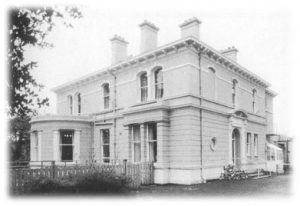 Sir Frederick Cleaver died suddenly on the evening of Saturday 31st March 1936, following his decision to take a walk from his home, Marlborough Park House, to which he had moved in 1927 (left). He had reached Stranmillis Road, when he collapsed and died. He was survived by his wife Lady Sarah Cleaver who died at Broomhill Park in December 1951. Like so many other members of the family, she also took an active interest in the work of the Methodist missions.
Sir Frederick Cleaver died suddenly on the evening of Saturday 31st March 1936, following his decision to take a walk from his home, Marlborough Park House, to which he had moved in 1927 (left). He had reached Stranmillis Road, when he collapsed and died. He was survived by his wife Lady Sarah Cleaver who died at Broomhill Park in December 1951. Like so many other members of the family, she also took an active interest in the work of the Methodist missions. John Cleaver’s eldest surviving daughter, Mabel, was born in March 1877 and in what was not perhaps a surprising move, she married Edward (Ned) Robinson on 12th June 1901 at University Road Methodist Church. Ned Robinson was the eldest son of Edward Robinson, one of the founders of Robinson & Cleaver and was a joint managing director of the firm at Donegall Place. They began their married life at a house on Somerton Park, but following the death of his father in 1906, they moved to a magnificent estate at Shaw’s Bridge overlooking the Lagan named Terrace Hill. It was the sale of the company to Edward De Stein in 1936, that precipitated the couple to demolish the original house of 1856. Ned and Mabel who enjoyed a fantastic social life, built a sprawling new house in an American neo-Georgian style, the design being executed by Young & McKenzie, (who designed the original store on Donegall Place in 1888) and in which they could entertain the cream of Ulster Society. Mabel had two daughters, who were brought up in a very privileged environment. Terrace Hill extended to over 9,200 sq feet, and had beautifully manicured gardens overlooking Barnett’s Demesne to Malone House on the other side of the valley. The house had tennis courts and a swimming pool. The eldest, Gwendoline, married Peter Swann, an insurance broker of the Wirral and left Northern Ireland in 1951, whilst Inez married Thomas Agnew, a land agent in Belfast. They were the last occupants to live at Macedon House at Whiteabbey, before it was taken over by Barnardo’s as a children’s home in 1950, as was Terrace Hill, after the departure of the Clokey family in 1970. Inez died in 1978 without issue
John Cleaver’s eldest surviving daughter, Mabel, was born in March 1877 and in what was not perhaps a surprising move, she married Edward (Ned) Robinson on 12th June 1901 at University Road Methodist Church. Ned Robinson was the eldest son of Edward Robinson, one of the founders of Robinson & Cleaver and was a joint managing director of the firm at Donegall Place. They began their married life at a house on Somerton Park, but following the death of his father in 1906, they moved to a magnificent estate at Shaw’s Bridge overlooking the Lagan named Terrace Hill. It was the sale of the company to Edward De Stein in 1936, that precipitated the couple to demolish the original house of 1856. Ned and Mabel who enjoyed a fantastic social life, built a sprawling new house in an American neo-Georgian style, the design being executed by Young & McKenzie, (who designed the original store on Donegall Place in 1888) and in which they could entertain the cream of Ulster Society. Mabel had two daughters, who were brought up in a very privileged environment. Terrace Hill extended to over 9,200 sq feet, and had beautifully manicured gardens overlooking Barnett’s Demesne to Malone House on the other side of the valley. The house had tennis courts and a swimming pool. The eldest, Gwendoline, married Peter Swann, an insurance broker of the Wirral and left Northern Ireland in 1951, whilst Inez married Thomas Agnew, a land agent in Belfast. They were the last occupants to live at Macedon House at Whiteabbey, before it was taken over by Barnardo’s as a children’s home in 1950, as was Terrace Hill, after the departure of the Clokey family in 1970. Inez died in 1978 without issue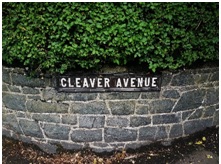 Today there are several reminders of the power and influence of the Cleaver family in Ireland, although there are no remaining family members now resident here. The site of the once magnificent family home and estate at Dunraven, is now covered in villa developments from the 1930s, when the house was sold, and is now known as Cleaver Park and Cleaver Avenue, off the Malone Road.
Today there are several reminders of the power and influence of the Cleaver family in Ireland, although there are no remaining family members now resident here. The site of the once magnificent family home and estate at Dunraven, is now covered in villa developments from the 1930s, when the house was sold, and is now known as Cleaver Park and Cleaver Avenue, off the Malone Road.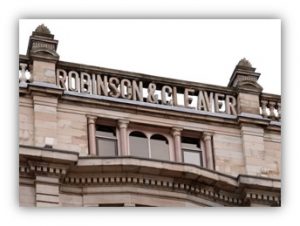 The magnificent department store buildings of Robinson & Cleaver still stand on the Corner of Donegall Place and Donegall Square North, as they do in London, although the family connection with the business was severed in 1936. The achievements of the company in obtaining several Royal Warrants and supplying Royal households across the world was none the less remarkable
The magnificent department store buildings of Robinson & Cleaver still stand on the Corner of Donegall Place and Donegall Square North, as they do in London, although the family connection with the business was severed in 1936. The achievements of the company in obtaining several Royal Warrants and supplying Royal households across the world was none the less remarkable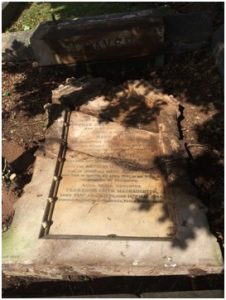 The final resting place of the Irish branch of the family can be found at Belfast City Cemetery, where there are three separate memorials. The saddest of these is the main family memorial which has only recently been revealed having been badly damaged by vandals during the period of civil unrest in Northern Ireland in the 1970s.
The final resting place of the Irish branch of the family can be found at Belfast City Cemetery, where there are three separate memorials. The saddest of these is the main family memorial which has only recently been revealed having been badly damaged by vandals during the period of civil unrest in Northern Ireland in the 1970s.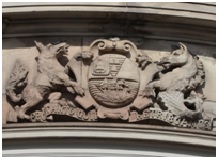
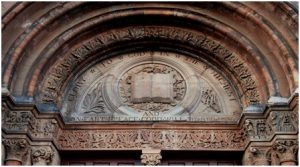
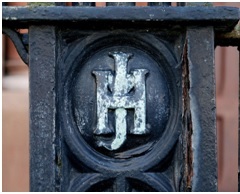
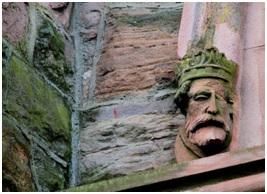 1922 – March 15th – Stained glass window is erected by Mrs. R.T. Martin to the memory of her husband, Mr. R.T. Martin and her son Lieut. John S. Martin. This window was dedicated by the Rev. J.R. Prenter.
1922 – March 15th – Stained glass window is erected by Mrs. R.T. Martin to the memory of her husband, Mr. R.T. Martin and her son Lieut. John S. Martin. This window was dedicated by the Rev. J.R. Prenter.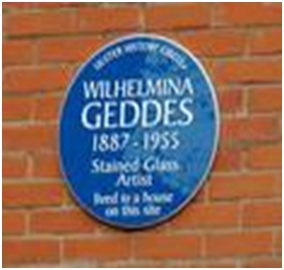
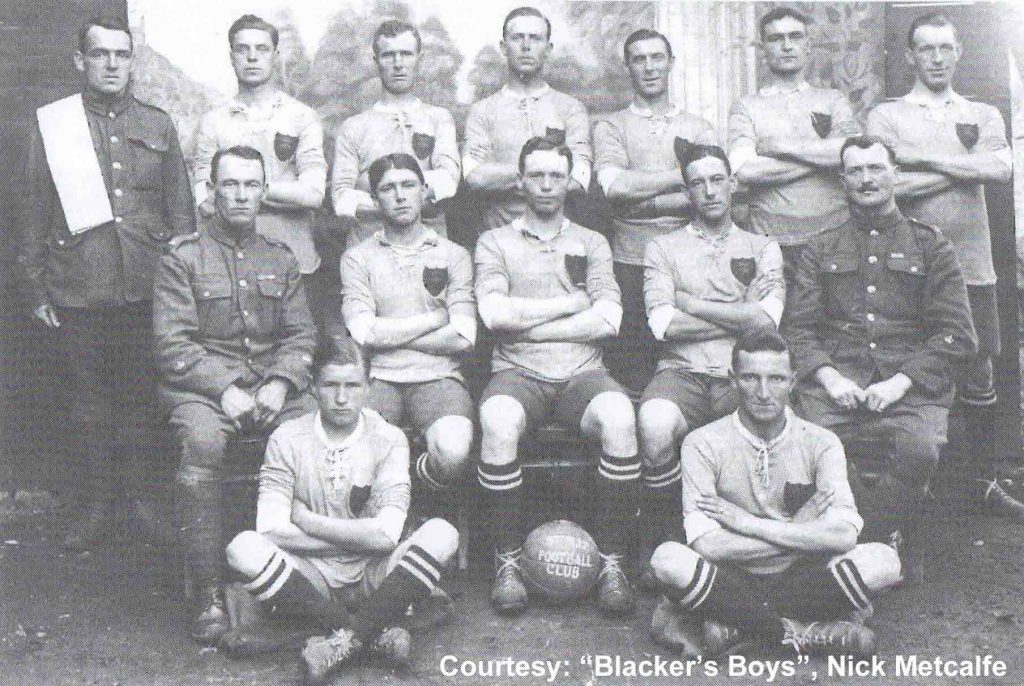
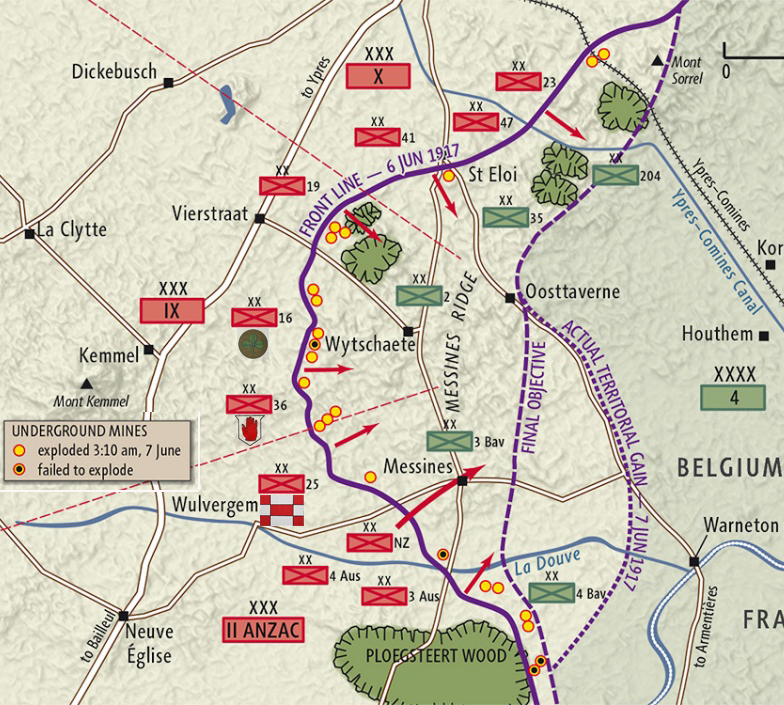
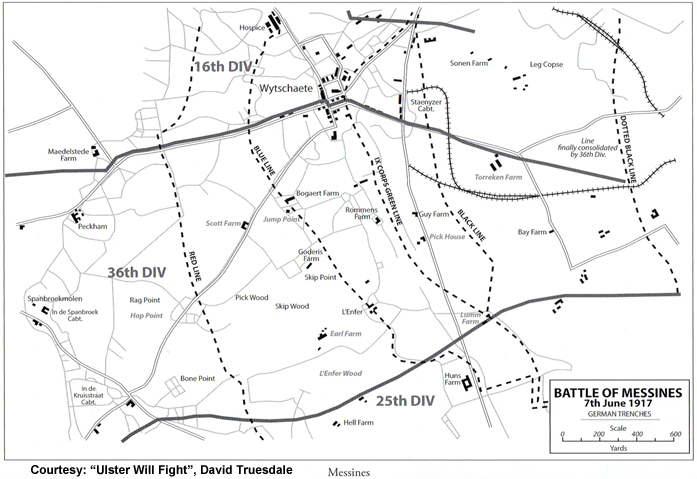
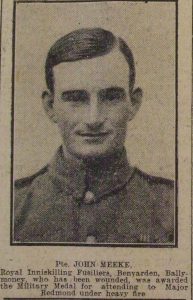 Another stretcher-bearer from the Ulster Division demonstrated that political allegiance had no place on the battlefield.
Another stretcher-bearer from the Ulster Division demonstrated that political allegiance had no place on the battlefield. 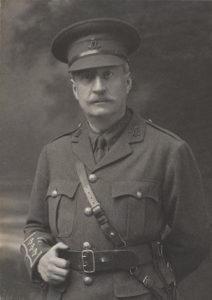
 Major Redmond to the casualty clearing station located in the Catholic Hospice at Locre but he died later that afternoon. John Meeke’s brother, Samuel, died of acute pulmonary tuberculosis on 19th January 1919, a fortnight after arriving home, and his grave in Derrykeighan Old Graveyard is marked by a Commonwealth War Graves Commission headstone.
Major Redmond to the casualty clearing station located in the Catholic Hospice at Locre but he died later that afternoon. John Meeke’s brother, Samuel, died of acute pulmonary tuberculosis on 19th January 1919, a fortnight after arriving home, and his grave in Derrykeighan Old Graveyard is marked by a Commonwealth War Graves Commission headstone.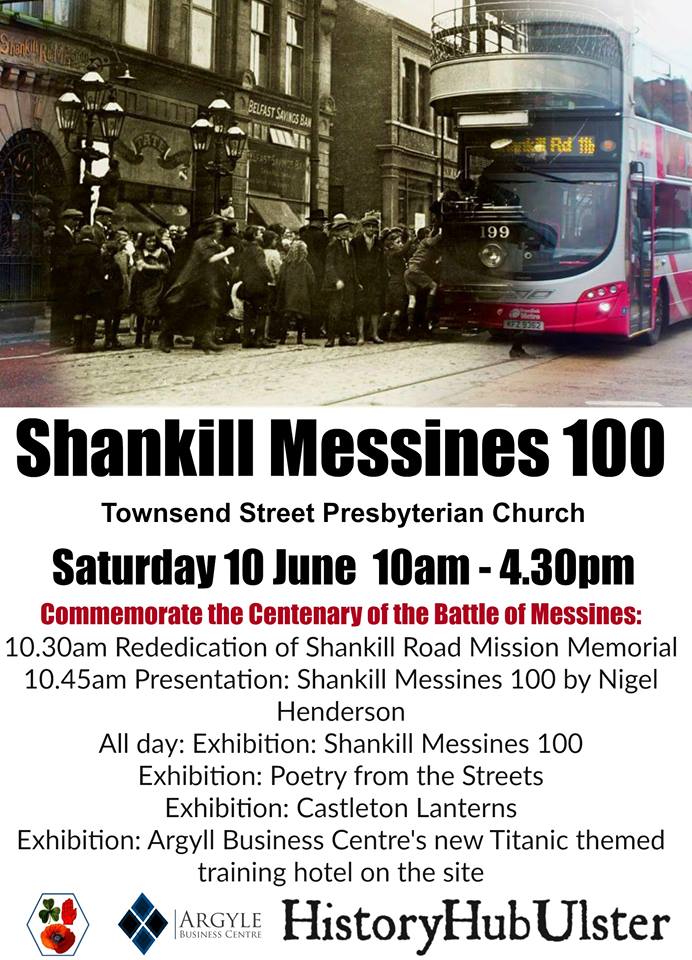
 In the Central Hall at Campbell College the photographs of 126 pupils and one member of staff who lost their lives in WW1 sit embedded in the wood panelled walls. Deteriorating over time these images need to be preserved and digitally restored before they are lost forever. ‘The Men Behind the Glass’ will seek to protect these images, whilst uncovering the real life stories behind these men.
In the Central Hall at Campbell College the photographs of 126 pupils and one member of staff who lost their lives in WW1 sit embedded in the wood panelled walls. Deteriorating over time these images need to be preserved and digitally restored before they are lost forever. ‘The Men Behind the Glass’ will seek to protect these images, whilst uncovering the real life stories behind these men.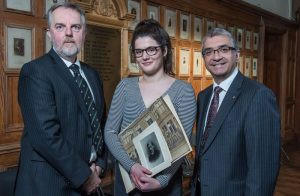 Mukesh Sharma, MBE, Committee Member for the Heritage Lottery Fund explains the importance of this project, “This is an exciting opportunity to open up the archives of Campbell College whose pupils played a key role in both WW1 and WW2. It offers the chance to pay respect to those lives lost but also to involve the whole community – encouraging everyone to tell the stories behind not just these 126 men, but all the men from East Belfast who made the ultimate sacrifice in WW1.”
Mukesh Sharma, MBE, Committee Member for the Heritage Lottery Fund explains the importance of this project, “This is an exciting opportunity to open up the archives of Campbell College whose pupils played a key role in both WW1 and WW2. It offers the chance to pay respect to those lives lost but also to involve the whole community – encouraging everyone to tell the stories behind not just these 126 men, but all the men from East Belfast who made the ultimate sacrifice in WW1.”